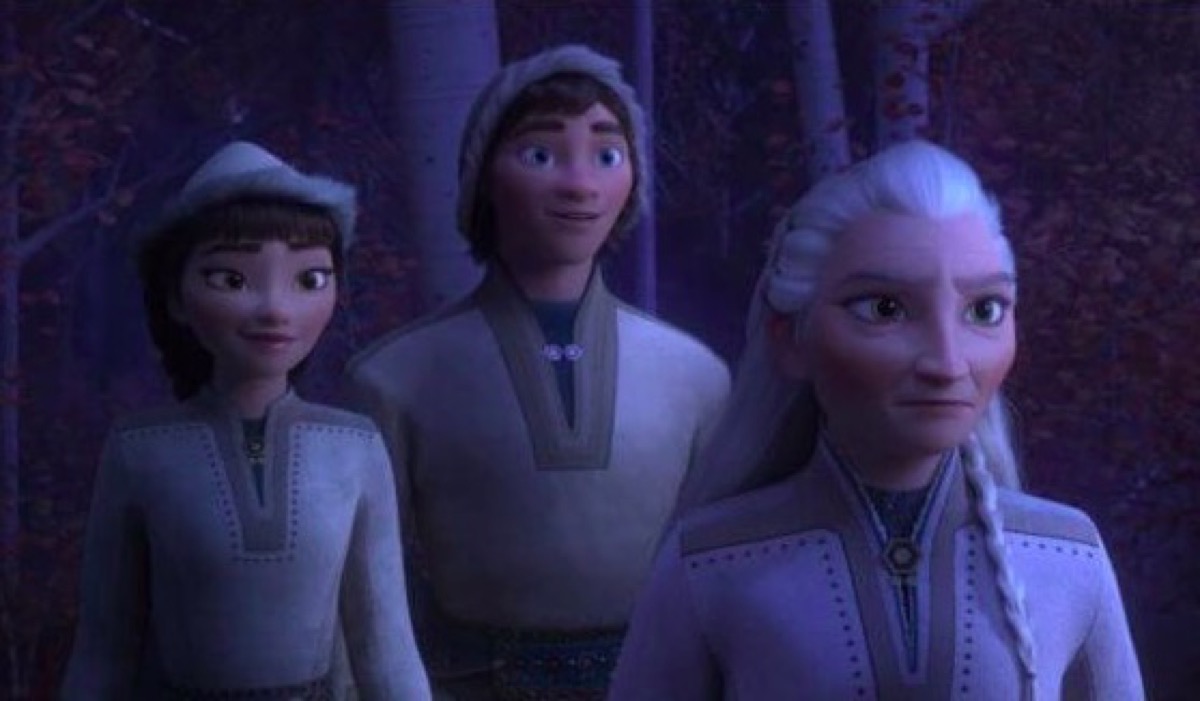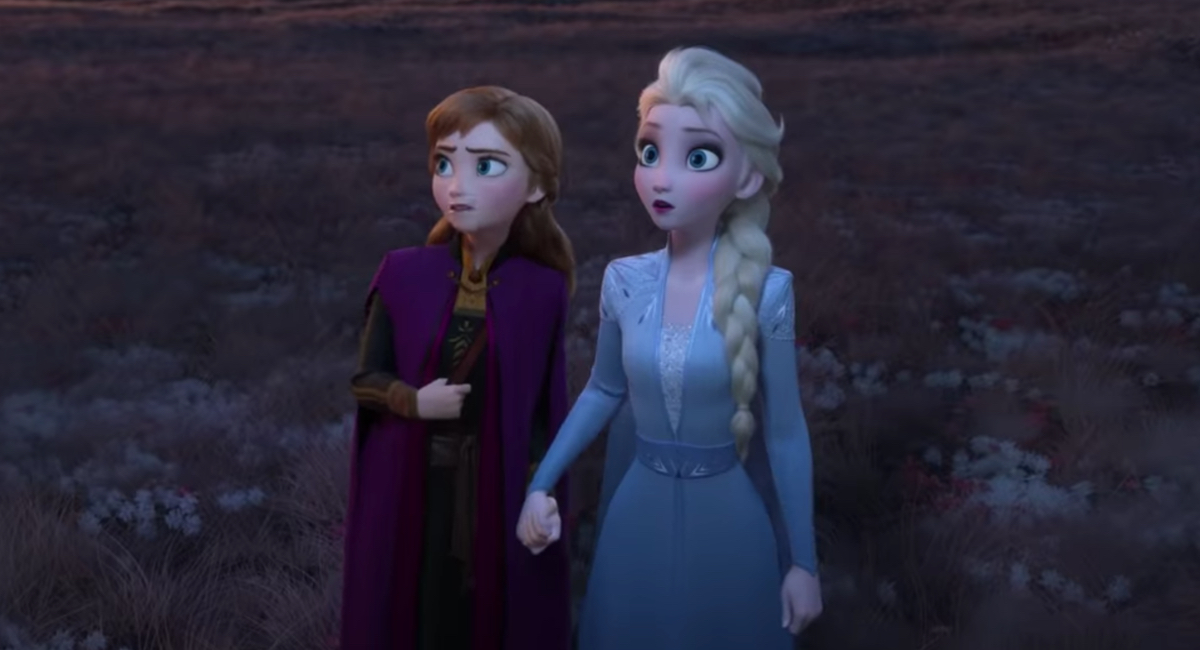Doing “The Next Right Thing”: Frozen 2’s Improvement on the Cautious White Feminism of the Original

The original Frozen seemed to revolutionize the classic Disney fairy tale film. No longer about a damsel in distress who dreams of “bigger things” and finds fulfillment in a heteronormative romance, the film explicitly satirizes that old chestnut of a plot, revealing “love at first sight” as a dangerous fiction taught to young girls who don’t know any better. Indeed, this film seems all about teaching girls how to navigate the challenges of patriarchal society.
Both Anna and Elsa are subject to exploitation by men: Hans and the comical—but no less insidious—Duke of Weselton. By forcing Elsa to conceal her powers, their father effectively destroys the sisterhood between Elsa and Anna for most of their young lives. Patriarchal exploitation is the villain in this film, and it is the sisters who must overcome it. Anna’s “act of true love” turns out to be for her sister instead of a man, marking the first time that Disney has ever celebrated sisterhood over hetero romance, suggesting that women might be able to help each other and themselves.
While I celebrated this film when it came out in 2013, it’s impossible to look at it in 2019 and not recognize that, while it’s a step forward for feminist representation in Disney’s fairy tale oeuvre, it is a cautious step at best. Frozen is about white feminism. There is virtually no consideration of intersectional aspects of identity because, besides their gender, Elsa and Anna live lives of unexamined privilege. They are white, rich, attractive, slender, able-bodied, and, at least in Anna’s case, straight.
As many articles before this one have explored, there is some celebration of Elsa’s coded queerness, but the film, I would argue, works hard to contain the radical potential of Elsa’s sexuality. After “Let it Go,” in which she celebrates her true nature and resolves to live “in the light of day” instead of concealing her powers, she is quickly informed that, if she tries to live the way she wants to, Arendelle will be frozen forever.
Essentially, by celebrating her true nature, she poses a threat to everyone else’s way of life. And so, the film must domesticate her powers; no longer a force of nature, she is reduced, in the end, to a party trick, conjuring cute little blizzards for Olaf and skating rinks for everyone’s amusement.
The film is equally cautious about its treatment of other social issues, most notably climate change. In many ways, Frozen enacts fears and fantasies about our relationship with the global climate in its treatment of ice. In the opening song, we learn that “ice has a power can’t be controlled,” that is “stronger than one, stronger than ten, stronger than a hundred men.” Ice—a stand-in for meteorological forces that can disrupt human existence—is scary.
Jennifer Lee’s screenplay walks a fine line on climate change, enabling us to embrace the fantasy that, through love, these scary forces of nature that threaten to upend everything we know might be tamed, and life as we know it can continue apace. Kristoff is made “Chief Ice Master and Deliverer” at the end of the film, a position for which Arendelle should have no need, as its queen can literally manufacture ice with a wave of her hand.
Nevertheless, we are assured that men will continue to mine the Earth for ice and deliver it for money; the climate change threatened by Elsa’s power, once tamed, will not disrupt the current economy in any way, despite the fact that the current economy is based, in large part, on the practices that cause climate change in the first place.
If Frozen is cautious, white feminism, Frozen II shows that Disney has learned to “Do the Next Right Thing” with respect to representation and social issues. Feminism, as a social movement, has evolved since 2013, and particularly since 2016. In addition to reigniting social activism within the feminist movement, the Women’s March and #MeToo highlighted the importance of intersectionality as an aspect of feminist discourse and activism. As a result of the shift away from the narrow focus of white feminism to a broader, intersectional view that considers all aspects of human identity, feminism itself has begun to partner with other causes beyond the scope of gender equity.
Take, for example, signs from the Women’s March in 2017 that read, “Women are in charge of their own bodies. Science is real. Black lives matter. Diversity is celebrated. Kindness is everything. Love is love.”
Feminism in 2019 acknowledges considerations of race and sexuality. It embraces the importance of action on climate change. And Frozen II gets all of that in a way that the original never did.
Frozen II is undeniably feminist. The sisters had to navigate a man’s world in the first film, but the second takes place in a world completely run by women. All of the leaders—from Elsa to Anna to the head of the Northuldra—are female. In a reversal of classic fairy tale tropes, the sisters learn that their mother saved their father’s life. The only arena in which the men dominate is charades (revealing the performative nature of toxic masculine posturing).
In the real world, Kristoff is “Lost in the Woods” without Anna, loves her for her ability to take charge, and supports her efforts, appearing in her hour of need not as a rescuer, but as backup. (“I’m here. What do you need?”) The central plot of the film revolves around atoning for the wrongs of a colonizing patriarch, Elsa and Anna’s grandfather, and it is women who negotiate that healing.
But the feminism of Frozen II is not white feminism, as the central plot reveals. The Northuldra are based on the indigenous peoples from Scandinavia known as the Sámi. After having appropriated a traditional Sámi song for the opening credits of the first film, Disney did the right thing this time, and partnered with the Sámi people in order to be sure that they were accurately honoring their cultural heritage, rather than appropriating it.
The screenplay goes well beyond mere representation for the Northuldra. Rather, its central plot enacts restitution for wrongs inflicted upon indigenous peoples by colonizers. At once acknowledging America’s original sin and Disney’s own careless appropriation of Sámi culture in the first film, Frozen II moves beyond the white feminism of its predecessor.
Frozen II also surpasses the original in its awareness of what it will take to combat climate change. The sisters are required to work with the natural world in order to appease the spirits’ anger. By destroying the dam, they allow nature to return to running the show; only then do “the spirits decide” that “Arendelle deserves to continue to exist.” This film gets that our very survival is contingent upon altering our relationship with nature, rather than continuing to exploit it.
Finally, Frozen II gives Elsa the ending she deserves. I know we were all hoping for a girlfriend, and there’s been much speculation about potential tensions with Honeymaren, but at the very least, Disney didn’t stifle her in the end this time. She finally gets to live as she wants to, exercising the fullest scope of her powers and just being herself.
Like Elsa, who forges ahead “Into the Unknown,” Disney took a step forward with Frozen II, and we’re looking forward to seeing more steps forward in the future. It’s nice to know that—with all apologies to Anna and Olaf’s first song—some things do change.
(images: Disney)
Want more stories like this? Become a subscriber and support the site!
—The Mary Sue has a strict comment policy that forbids, but is not limited to, personal insults toward anyone, hate speech, and trolling.—
Have a tip we should know? [email protected]
